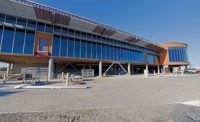Groundwater Cooling
The original cooling design for the addition called for a traditional chiller plant with two 200-ton chillers that required a combined 400 horsepower. Collaborating with the engineering team at Bozeman-based Morrison Maierle Inc., mechanical engineer Larry Bronec of Bronec and Associates in Bozeman devised an alternative plan for a groundwater cooling system that required two 30-hp well pumps. Though more involved and expensive at the onset, the system has the potential to save the airport an estimated $58,000 in electricity annually, Bronec says.
The system utilizes the fairly constant 50-degree temperature of the groundwater aquifer, which is continuously recharged by the south-to-north drainage slope of the Gallatin River Valley. The well water is pumped into the building, where it passes through a flat-plate heat exchanger. Depending on the level of cooling required, the heat exchanger will either extract heat from the groundwater and transfer it to the building's chilled water loop or extract heat from the building's chilled water loop and transfer it back into the groundwater.
Sixteen air handler units—divided between a basement mechanical room and an upper-level fan room—use the chilled water to cool the air circulated through the building ducts. Two 10-in.-wide wells on the south side of the terminal supply the system, and the water is returned to the aquifer by a single 8-in.-wide injection well on the north side. The down-gradient location of the injection well ensures that the expelled warmer water drains away from the supply wells and does not recirculate through the system.
Maintaining the temperature stability of the groundwater is critical to the system's efficiency, says project geologist Pat Eller of Morrison Maierle. Each well is lined with a steel casing fitted with a length of stainless steel screen at the bottom. Morrison Maierle's in-house laboratory designed the screens using gradation curves that showed it was possible to utilize a 200-slot screen size—a rather large slot size that allowed for the fast development of the well, Eller says. Water Rights Over the course of six weeks, Potts Drilling Inc. of Bozeman drilled the wells using dual rotary casing-advance air-drilling methods that discharged materials directly into a cyclone sampler for accurate sampling as drilling progressed.
The samples were analyzed to determine the depth of the well and the slot-screen size needed to attain the proper water flow to satisfy the building's cooling load. The finished well system features two 560-gallon-per-minute submersible pumps, one for each supply well. Obtaining the proper permits and water rights took nearly two years. “You have to invest into the infrastructure and put a lot of time into the engineering, but there's always the chance that you will not attain the water rights if the testing shows that the wells injure the water quality in some way,” Eller says.
As part of the water rights application through the Montana Dept. of Natural Resources and Conservation, the engineering team used aquifer information gathered on site to develop an analytical model demonstrating that the pumping was not adversely affecting the water table or senior water rights holders in the area. Water rights were awarded in June. Two gas-fired boilers supply the heating for the older portion of the building, and three high-efficiency gas-fired boilers were installed to heat the new addition. The boilers will provide the primary heating until the system is switched over to groundwater heating.
In addition to lighting upgrades, high-efficiency windows and well-insulated construction, the airport also installed a heat-reclaim system. An air-to-air heat exchanger in the upper-level fan room reclaims the heat from the bathroom exhaust and transfers that heat to the building ventilation air. Roughly 80% of the heat that would have otherwise exited the building or been wasted is reclaimed, saving the airport roughly $8,000 per year in heating costs, Bronec says.
“With all the energy-efficiency measures, we expect to save about 30% on utility bills,” Sprenger says.








Post a comment to this article
Report Abusive Comment